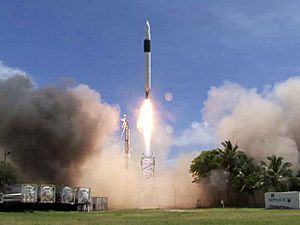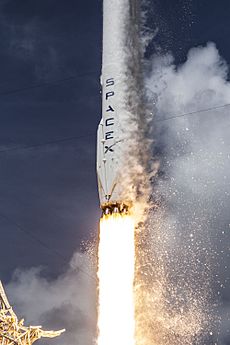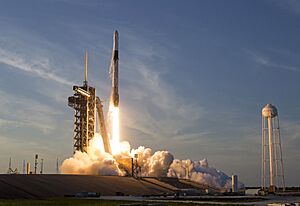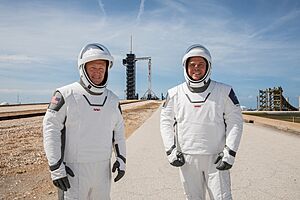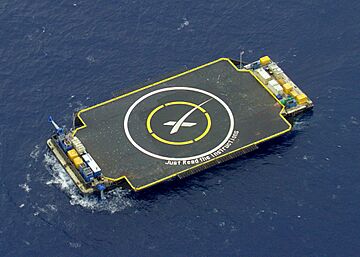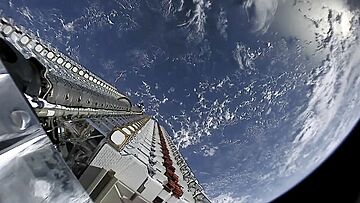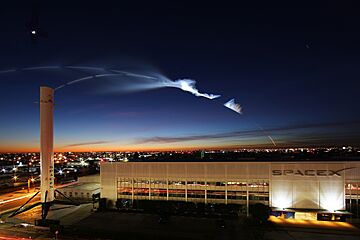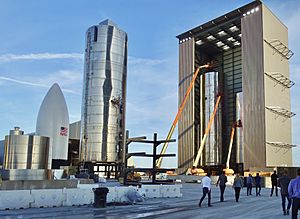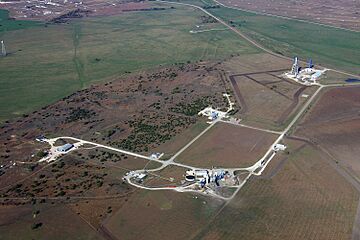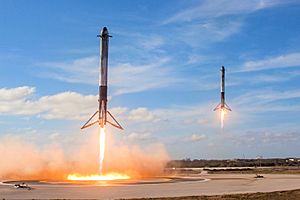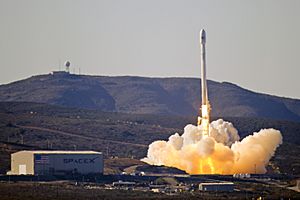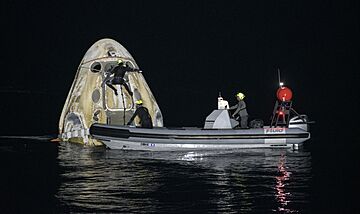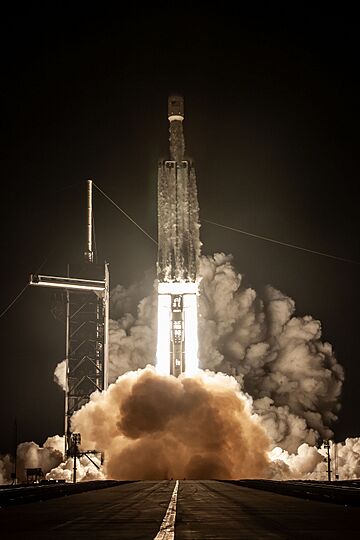SpaceX facts for kids
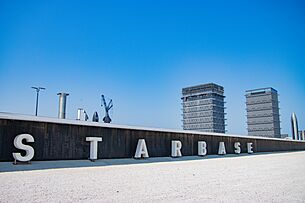
Company headquarters, SpaceX Starbase in Starbase, Texas
|
|
|
Trade name
|
SpaceX |
|---|---|
| Private | |
| Industry |
|
| Founded | March 14, 2002 in El Segundo, California, U.S. |
| Founder | Elon Musk |
| Headquarters | SpaceX Starbase,
Starbase, Texas
,
U.S.
|
|
Key people
|
|
| Products |
|
| Revenue | |
|
Operating income
|
|
| Owner |
|
|
Number of employees
|
13,000+ (September 2023) |
| Subsidiaries |
|
Space Exploration Technologies Corp., known as SpaceX, is an American company that builds rockets and spacecraft. Its main office is in Starbase, Texas. Since it started in 2002, SpaceX has made big steps in rocket technology. They have created rockets that can be reused and spacecraft that carry people. They also build large groups of satellites.
As of 2025, SpaceX launches more rockets than any other company in the world. This includes other private companies and even national space programs. SpaceX works closely with NASA and the United States Armed Forces on many projects.
Elon Musk started SpaceX in 2002. His goal was to make space travel much cheaper. He also wanted to help create a way for humans to live on Mars. In 2008, their first rocket, Falcon 1, successfully reached orbit after three tries. After that, SpaceX built the larger Falcon 9 rocket and the Dragon 1 capsule. These were used to deliver supplies to the International Space Station (ISS) for NASA.
By 2012, SpaceX began regular supply missions to the ISS. Around this time, they also started working on making the Falcon 9 rocket's first stage reusable. This means the bottom part of the rocket can land back on Earth and be used again. In 2015, they successfully landed a Falcon 9 first stage. Then, in 2017, they launched a reused first stage into space again. The Falcon Heavy rocket, which is made of three Falcon 9 boosters, first flew in 2018. As of July 2025, Falcon 9 rockets have landed and flown again over 450 times. They now launch rockets almost every week.
These achievements helped SpaceX get a lot of money to invest. The company then started to find new ways to earn money. In 2019, they launched the first working satellite for Starlink. This is a group of satellites that provides internet service. In the years that followed, Starlink became a major source of income for SpaceX. It also led to Starshield, a similar system for military use.
In 2020, SpaceX began using its Dragon 2 capsules to fly astronauts for NASA and other groups. Around this time, SpaceX also started building test versions of Starship. This is the biggest rocket ever built. Starship aims to make space travel fully reusable, affordable, and flexible. SpaceX is also creating its own space suits and training astronauts through its Polaris program. They are also building a human lander for moon missions as part of NASA's Artemis program.
Contents
- The Story of SpaceX
- SpaceX Technology
- Other SpaceX Projects
- SpaceX Locations
- Contracts and Partnerships
- Competition in the Launch Market
- Company Information
- Government Investigations
- Environmental Impact
- See also
The Story of SpaceX
How SpaceX Began (2001–2004)
In 2001, Elon Musk met Robert Zubrin and gave money to his Mars Society. Musk wanted to send a greenhouse to Mars to grow plants. He first tried to buy rockets from Russia, but it didn't work out. On the way home, Musk decided to start his own company to build affordable rockets.
He believed he could make rockets much cheaper by building most parts himself. He also planned to use parts that were already available and use a modular design, like in software. In early 2002, Elon Musk started looking for people to join his new company, which he named SpaceX.
SpaceX first set up its office in a warehouse in El Segundo, California. Many early employees came from other big aerospace companies nearby. By 2005, SpaceX had 160 employees. Musk personally interviewed almost all of them. One of Musk's main goals for SpaceX was to make space travel ten times cheaper and more reliable.
First Rockets: Falcon 1 (2005–2009)
SpaceX built its first rocket, the Falcon 1, using its own money. The Falcon 1 was a small rocket that could carry a few hundred kilograms into orbit. It cost about $90 million to $100 million to develop. The Falcon rockets were named after the Millennium Falcon from Star Wars.
In 2006, NASA chose SpaceX to help deliver supplies to the International Space Station (ISS). They gave SpaceX $396 million to show they could do this. The first two Falcon 1 launches were for the U.S. Department of Defense. However, the first three launches, from 2006 to 2008, all failed. These failures almost caused the company to go out of business.
Things started to get better with the first successful launch on September 28, 2008. After this, NASA gave SpaceX a $1.6 billion contract in December. This contract helped save the company financially. The Falcon 1 was then retired after its fifth and final launch in July 2009. This allowed SpaceX to focus on building a larger rocket, the Falcon 9.
Falcon 9, Dragon, and NASA (2010–2012)
SpaceX decided to build the Falcon 9, a much larger rocket, in 2005. NASA helped speed up its development by promising to buy flights if SpaceX showed certain abilities. NASA gave SpaceX $278 million to develop the Dragon spacecraft and the Falcon 9. The Falcon 9 first launched in June 2010 with a test version of the Dragon spacecraft.
The first working Dragon spacecraft launched in December 2010. It successfully returned to Earth after orbiting twice. By December 2010, SpaceX was building one Falcon 9 and Dragon every three months. In April 2011, NASA gave SpaceX $75 million to develop a way for Dragon to escape safely if there was a problem during launch. This was to prepare it for carrying humans.
In May 2012, the Dragon spacecraft became the first commercial spacecraft to deliver cargo to the International Space Station. After this flight, SpaceX's value almost doubled to $2.4 billion. By this time, SpaceX had used about $1 billion in funding over its first ten years. Elon Musk himself invested about $100 million.
SpaceX also started testing ways to land its rockets in late 2012. They tested low-altitude, low-speed landings. Later, in 2013, they began testing high-speed, high-altitude returns of the rocket boosters.
Commercial Growth and Challenges (2013–2015)
SpaceX launched its first mission for a private customer in 2013. In 2014, SpaceX won nine out of 20 global launch contracts. This competition led other rocket companies to ask for more government help. SpaceX's lower prices also started to affect the market for U.S. military launches. For almost ten years, one company, United Launch Alliance (ULA), had controlled this market. Their launch costs had risen to over $400 million.
In September 2014, NASA gave SpaceX a contract to finish developing its system for transporting astronauts. This contract included test flights and six missions after the system was ready. In January 2015, SpaceX received $1 billion in funding from Google and Fidelity Investments. This made the company worth about $12 billion. The same month, SpaceX announced Starlink, a new satellite system to provide global internet.
In June 2015, a Falcon 9 rocket failed during its seventh mission to resupply the ISS. The rocket exploded two minutes after launch. The problem was a broken steel support that held a helium tank. This caused high-pressure helium to leak and led to the explosion.
Reusable Rockets Take Flight (2015–2017)
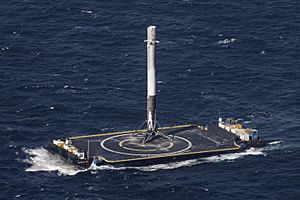
SpaceX successfully landed a Falcon 9 first stage on land in December 2015. In April 2016, they achieved the first successful landing on a floating platform in the ocean. This platform is called an autonomous spaceport drone ship (ASDS). By October 2016, SpaceX offered customers a 10% discount if they used a reused Falcon 9 first stage.
Another rocket failure happened in September 2016. A Falcon 9 exploded during a test before launch. A $200 million satellite was destroyed. The explosion happened because the liquid oxygen fuel became too cold and reacted with carbon parts. This caused a four-month break in launches while SpaceX investigated. SpaceX started launching again in January 2017.
In March 2017, SpaceX launched a Falcon 9 that had already flown once. This was the first time a reused orbital rocket carried a satellite back into space. The first stage was recovered again, making it the first time a reused rocket landed twice.
Global Launch Leader (2017–2018)
In July 2017, SpaceX raised $350 million, increasing its value to $21 billion. In 2017, SpaceX won 45% of all commercial launch contracts worldwide. By March 2018, SpaceX had over 100 launches planned, worth about $12 billion in contracts. This made SpaceX the top commercial launch provider globally.
In 2017, SpaceX started a new company called The Boring Company. This company began building a short test tunnel near SpaceX's headquarters. The tunnel was finished in May 2018. Later, The Boring Company became a separate business.
Starship, Crewed Flights, and Starlink (Since 2019)
In 2019, SpaceX raised $1.33 billion. By May 2019, SpaceX was worth $33.3 billion, and by March 2020, it reached $36 billion. In August 2020, after raising $1.9 billion, SpaceX's value grew to $46 billion.
By February 2021, SpaceX was worth about $74 billion. By 2021, SpaceX had raised over $6 billion. Most of this money was used for the Starlink satellite system and developing the Starship rocket. By October 2021, SpaceX's value reached $100.3 billion. In April 2021, Starship was chosen to be the human lander for NASA's Artemis program to the Moon.
In July 2021, SpaceX introduced another drone ship named A Shortfall of Gravitas. They landed a booster on it for the first time in August 2021. In 2022, SpaceX had 18 rocket launches and two astronaut splashdowns in the first 130 days. In December 2021, Elon Musk announced that SpaceX was starting a program to turn captured carbon dioxide into rocket fuel.
In August 2022, the European Space Agency (ESA) talked with SpaceX about using their rockets. This was because Russia had stopped providing Soyuz rockets due to the war in Ukraine. Starlink was used a lot during the war between Russia and Ukraine.
In 2022, SpaceX's Falcon 9 set a world record for the most launches of a single rocket type in one year. SpaceX launched a rocket about every six days in 2022, with 61 launches in total. All but one were Falcon 9 rockets.
In November 2023, SpaceX bought its parachute supplier, Pioneer Aerospace, for $2.2 million. In July 2024, Elon Musk announced that SpaceX would move its main office from California to SpaceX Starbase in Brownsville, Texas. This move was largely symbolic, as the California facility still supports Falcon rocket production.
SpaceX's Polaris Dawn mission in 2024 included the first-ever private spacewalk. This was a big step for private space exploration. In July 2025, SpaceX agreed to invest $2 billion in xAI.
Starship Development
In January 2019, SpaceX announced it would reduce its workforce by 10%. This was to help pay for the Starship and Starlink projects. The goal of Starship is to carry many people and a lot of cargo to the Moon, Mars, and beyond. Starship is the largest and most powerful rocket ever flown. It can carry over 100 tons. Building and testing Starship started in early 2019 in Florida and Texas. All Starship work later moved to the new SpaceX South Texas launch site.
On April 20, 2023, Starship's first orbital test flight ended with an explosion in the air. Several engines failed, and the rocket lost control. The automatic safety system then destroyed the rocket. Elon Musk and others in the space industry still called the test flight a success.
Musk said it would take "six to eight weeks" to prepare for another launch. In October 2023, a SpaceX executive said the company was ready to launch in September. He said government delays could let China reach the Moon before the U.S.
On November 18, 2023, Starship launched on its second test flight. Both parts of the rocket flew for a few minutes before exploding separately. In early March 2024, SpaceX aimed for a March 14 launch date for its next uncrewed Starship test. The FAA gave permission on March 13, 2024. On March 14, 2024, Starship launched for the third time. It reached its planned path, but the booster had a problem before landing. The ship was lost during its return over the Indian Ocean.
On June 4, 2024, SpaceX got permission for Starship's fourth flight test. This time, the FAA allowed SpaceX to launch future tests without a new investigation if they were similar. This could speed up development.
On October 12, 2024, SpaceX got FAA approval for Starship's fifth flight test. This flight had no engine failures and was the first successful "tower catch" of the booster. SpaceX launched Starship on its sixth flight test on November 19, 2024. The booster did not attempt a catch, and the ship restarted its engine in space.
On January 16, 2025, Starship launched on its seventh flight test. This was the first flight of the new, taller Ship 33. It also carried a test satellite. The booster was successfully caught by the tower. However, SpaceX lost contact with the upper stage after 8 minutes, and it failed during its ascent. The spacecraft reportedly exploded over the Atlantic Ocean. The FAA required an investigation into the failure.
On March 7, 2025, another Starship rocket launched from Texas. Contact was lost minutes into the flight, and the spacecraft broke apart. An early investigation showed an oxygen leak and fires caused the engines to shut down. This activated the self-destruct system.
On June 18, 2025, a Starship rocket exploded during a test at the Starbase facility in Texas. SpaceX called it a "major anomaly."
Sending Astronauts to Space
A big moment happened in May 2020. SpaceX successfully launched two NASA astronauts, Doug Hurley and Bob Behnken, into orbit. They flew on a Crew Dragon spacecraft. This made SpaceX the first private company to send astronauts to the International Space Station. It was also the first time astronauts launched from American soil in nine years. The mission launched from Florida.
Starlink Internet
In May 2019, SpaceX launched the first large group of 60 Starlink satellites. This began the creation of the world's largest commercial satellite system. In 2022, most SpaceX launches were for Starlink. This business sends internet-beaming satellites into space. There are now over 6,000 Starlink satellites in orbit.
In July 2021, SpaceX bought Swarm Technologies, a company that builds small satellites for connecting to Internet of Things (IoT) devices. In December 2022, the U.S. government allowed SpaceX to launch up to 7,500 more Starlink satellites.
Astronomers have worried that the large number of Starlink satellites might make the sky too bright. This could interfere with scientific observations. SpaceX has made changes to its satellites to make them less bright. The many satellites also create a risk of space debris collisions. However, the satellites have special engines that allow them to move out of orbit at the end of their life. They can also avoid collisions on their own.
In December 2022, SpaceX announced Starshield. This program puts military or government equipment on Starlink-like satellites. The Space Development Agency is a key customer. They are buying satellites for a space-based missile defense system.
In June 2024, SpaceX released a smaller Starlink antenna called "Starlink Mini." It is designed for mobile internet use. It costs $599 and is smaller and lighter than the standard version. It has a built-in WiFi router and fast download speeds.
Major Achievements
| Date | Achievement | Flight |
|---|---|---|
| September 28, 2008 | First privately funded, liquid-fueled rocket to reach orbit. | Falcon 1 Flight 4 |
| July 14, 2009 | First privately funded, liquid-fueled rocket to put a commercial satellite in orbit. | Falcon 1 Flight 5 |
| December 9, 2010 | First private company to successfully launch, orbit, and recover a spacecraft. | SpaceX COTS Demo Flight 1 |
| May 25, 2012 | First private company to send a spacecraft to the International Space Station (ISS). | SpaceX COTS Demo Flight 2 |
| December 22, 2015 | First landing of an orbital rocket's first stage on land. | Falcon 9 Flight 20 |
| April 8, 2016 | First landing of an orbital rocket's first stage on an ocean platform. | SpaceX CRS-8 |
| March 30, 2017 | First reuse and (second) landing of an orbital first stage. | SES-10 |
| First controlled return and recovery of a payload fairing (rocket nose cone). | ||
| June 3, 2017 | First reuse of a commercial cargo spacecraft. | SpaceX CRS-11 |
| February 6, 2018 | First private spacecraft launched into orbit around the Sun. | Falcon Heavy test flight |
| March 2, 2019 | First private company to send a human-rated spacecraft to orbit. | Crew Dragon Demo-1 |
| March 3, 2019 | First private company to automatically dock a human-rated spacecraft to the ISS. | |
| July 25, 2019 | First flight of a new type of rocket engine (Raptor). | Starhopper |
| November 11, 2019 | First reuse of a payload fairing. | Starlink 2 v1.0 |
| May 30, 2020 | First private company to send humans into orbit. | Crew Dragon Demo-2 |
| First private company to send humans to the ISS. | ||
| January 24, 2021 | Most spacecraft launched on a single mission (143 satellites). | Transporter-1 |
| April 23, 2021 | First reuse of a crewed space capsule. | SpaceX Crew-2 / Endeavour |
| First reused booster to send humans into orbit. | ||
| June 17, 2021 | First reused booster to launch a 'national security' mission. | GPS III-05 |
| September 16, 2021 | First orbital launch of an all-private crew. | Inspiration4 |
| November 24, 2021 | Longest streak of orbital launches without a mission failure for a single rocket type (Falcon 9, 101 launches). | Double Asteroid Redirection Test |
| April 9, 2022 | First all-private crew to dock with the International Space Station. | Axiom Mission 1 |
| October 20, 2022 | Highest number of launches of a single rocket type in a calendar year (Falcon 9, 48 launches). | Starlink 4-36 |
| April 20, 2023 | Tallest, most massive, most powerful rocket to ever launch. | SpaceX Starship orbital test flight |
| March 14, 2024 | Starship reaches intended orbital velocity for the first time. | SpaceX Starship integrated flight test 3 |
| April 12, 2024 | A single Falcon 9 booster reused for the 20th time. | Booster 1062 |
| September 12, 2024 | First commercial spacewalk | Polaris Dawn |
| October 13, 2024 | First Super Heavy booster catch | Starship flight test 5 |
| November 19, 2024 | First in space relight of a new type of engine (Raptor). | Starship flight test 6 |
SpaceX Technology
Rockets and Launch Vehicles
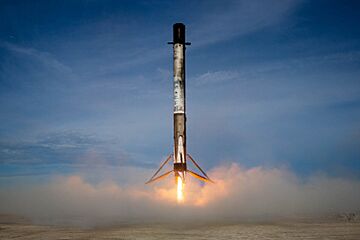
SpaceX has built three types of rockets. The small Falcon 1 rocket was retired in 2009. The Falcon 9 (medium-sized) and the Falcon Heavy (heavy-lift) rockets are both currently in use.
The Falcon 1 was a small rocket that could put a few hundred kilograms into orbit. It launched five times between 2006 and 2009, with two successful flights. It was the first privately funded, liquid-fueled rocket to reach orbit.
The Falcon 9 is a medium-sized rocket. It can carry up to 22,800 kilograms (50,265 pounds) into orbit. It competes with other rockets like the Delta IV and Atlas V. The Falcon 9 has nine Merlin engines in its first stage. Its first flight was successful on June 4, 2010. In May 2012, it launched the first commercial spacecraft to reach and dock with the International Space Station. The Falcon 9 has been updated several times. Its first stage is designed to land and be reused.
The Falcon Heavy is a very powerful rocket. It can carry up to 63,800 kilograms (140,700 pounds) to low Earth orbit. It uses three slightly changed Falcon 9 first stages, with a total of 27 Merlin 1D engines. The Falcon Heavy first flew on February 6, 2018. It launched Elon Musk's personal Tesla Roadster into orbit around the Sun.
Both the Falcon 9 and Falcon Heavy are approved for U.S. military launches. As of July 2025, the Falcon 9 and Falcon Heavy have launched many times. Most of these missions have been fully successful.
SpaceX is also developing a fully reusable, super-heavy rocket system called Starship. It has a reusable first stage called Super Heavy and a reusable upper stage called Starship. This system is meant to replace SpaceX's current rockets.
Rocket Engines
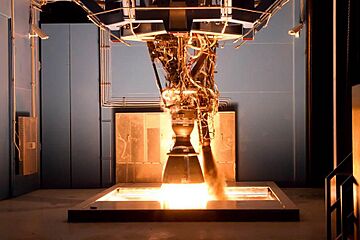
SpaceX has developed several rocket engines. These include Merlin, Kestrel, and Raptor. They also have Draco engines for steering Dragon spacecraft and SuperDraco engines for emergency escapes.
Merlin engines use liquid oxygen and rocket fuel (RP-1). Merlin engines were first used on the Falcon 1. Now, they power both stages of the Falcon 9 and Falcon Heavy rockets. Kestrel engines use the same fuels and were used on the Falcon 1's second stage.
Draco and SuperDraco engines use special liquid fuels that ignite when mixed. Draco engines are used for steering the Dragon and Dragon 2 spacecraft. SuperDraco engines are more powerful. Eight SuperDraco engines help the Crew Dragon spacecraft escape safely in an emergency.
Raptor is a new family of engines. They use liquid oxygen and liquid methane fuel. These engines will power the Starship rocket system. Test versions were fired in late 2016. The engine first flew in 2019, powering the Starhopper vehicle.
Dragon Spacecraft
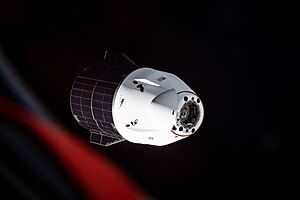
SpaceX built the Dragon spacecraft to carry cargo and astronauts to the International Space Station (ISS).
The first Dragon spacecraft, Dragon 1, was only for cargo. NASA helped fund its development. After a successful test flight in 2010, SpaceX received a contract to deliver cargo.
The current Dragon 2 spacecraft first flew without a crew to the ISS in early 2019. Then, in 2020, it made a crewed flight. NASA also helped fund this version. The cargo version of Dragon 2 first flew in December 2020, delivering supplies to the ISS.
In March 2020, SpaceX showed off the Dragon XL. This spacecraft is designed to resupply NASA's planned Lunar Gateway space station. Dragon XL will launch on the Falcon Heavy and can carry over 5,000 kilograms (11,000 pounds) to the Gateway. It will stay docked at the Gateway for six to twelve months.
SpaceX also designed a spacesuit for use inside the Dragon spacecraft. This suit protects astronauts if the cabin loses pressure. In May 2024, SpaceX showed a second spacesuit. This one is for spacewalks and was used during the Polaris Dawn mission.
Drone Ships for Landing Rockets
SpaceX regularly lands the first stage of its Falcon 9 and Falcon Heavy rockets after they launch. The rocket lands at a specific site using its engines. If there isn't enough fuel to return to the launch site, the rockets land on a floating platform in the ocean. These platforms are called autonomous spaceport drone ships (ASDS).
SpaceX also planned to use floating launch platforms, which would be changed oil rigs. These would allow Starship rockets to launch from the sea. As of February 2023, SpaceX had sold the oil rigs but might still use sea-based platforms in the future.
Starlink Satellite Internet
Starlink is an internet satellite system being built by a SpaceX company. It has thousands of satellites in orbit about 550 kilometers (340 miles) above Earth. Its goal is to provide affordable internet to people worldwide. Development started in 2015. The first group of 60 satellites launched in May 2019.
Testing of the system began in late 2020, and customers started ordering service in early 2021. Customers can expect internet speeds of 50 to 150 megabits per second. By December 2022, Starlink had over 1 million subscribers globally.
Astronomers have raised concerns about Starlink satellites being too bright. This can interfere with scientific observations. SpaceX has made changes to its satellites to reduce their brightness. The large number of satellites also creates a risk of space debris collisions. However, the satellites have special thrusters that allow them to move out of orbit when they are no longer needed. They are also designed to avoid collisions on their own.
In December 2022, SpaceX announced Starshield. This program puts military or government equipment on Starlink-like satellites. The Space Development Agency is buying satellites for a space-based missile defense system.
In June 2024, SpaceX introduced a smaller Starlink antenna called "Starlink Mini." It is designed for mobile internet use. It costs $599 and is smaller and lighter than the standard version. It has a built-in WiFi router and fast download speeds.
Other SpaceX Projects
Hyperloop Competition
In June 2015, SpaceX announced it would sponsor a Hyperloop competition. They built a 1.6-kilometer (1-mile) test track near their headquarters for the event. The company held this yearly competition from 2017 to 2019.
COVID-19 Antibody Testing
In 2020, SpaceX worked with doctors and researchers on a COVID-19 antibody-testing program. Over 4,300 employees volunteered to give blood samples. This led to a scientific paper that suggested a certain level of COVID-19 antibodies might protect against the virus. Eight SpaceX employees were listed as co-authors.
Other Efforts
In July 2018, Elon Musk arranged for his employees to build a mini-submarine. This was to help rescue children stuck in a flooded cave in Thailand. The leader of the rescue team asked Musk for help. However, the mini-submarine was not used because it was not practical for the mission. SpaceX and The Boring Company engineers built the submarine quickly from rocket parts.
SpaceX Locations
SpaceX's main office is now at SpaceX Starbase near Brownsville, Texas. This is where they build and launch their Starship rocket. However, most of the company's other work happens at its office in Hawthorne, California. Here, they build Falcon rockets and Dragon spacecraft. This location also has their mission control center.
The company also has a Starlink satellite factory in Redmond, Washington. They have a rocket development and test facility in McGregor, Texas. There is also an office in Washington, D.C., close to government customers.
SpaceX has two active launch sites in Florida, one in California, and one at Starbase in Texas.
Hawthorne, California: Falcon and Dragon Production
SpaceX has a large facility in Hawthorne, California. This building used to be where Boeing 747 airplane parts were made. Now, it holds SpaceX's offices, mission control, and Falcon 9 rocket factories.
This area has many space companies and engineers. SpaceX builds most of its rocket parts, engines, spacecraft, and software in-house at this facility. This is unusual for the space industry. The Hawthorne facility was SpaceX's main office until August 2024. However, it remains a very important part of the company's operations.
Boca Chica, Texas: Starship Production and Launch
SpaceX builds and flies Starship test rockets from SpaceX Starbase in Boca Chica. They announced plans for this launch site in August 2014. The Federal Aviation Administration (FAA) gave permission in July 2014. Construction started in 2014. The first suborbital launches from here were in 2019, and orbital launches began in 2023.
SpaceX has faced concerns about the environmental impact of its Starbase facility. In August 2024, Texas officials said SpaceX broke environmental rules by releasing pollutants into water near the launch site. The EPA also fined SpaceX for allegedly releasing "industrial wastewater."
McGregor, Texas: Rocket Testing
SpaceX's Rocket Development and Test Facility in McGregor, Texas, is where they test rocket engines. Every engine and thruster made by SpaceX is tested here before it is used on a mission. The facility also tests different parts and engines during the design process. After Dragon spacecraft land in the ocean, they stop at McGregor to have their dangerous fuels removed. Then, they go to Hawthorne for repairs.
SpaceX calls this facility the most advanced and active rocket engine test site in the world. As of 2024, over 7,000 tests had been done there. Typically, seven engine tests happen each day. Even though it's not as well-known as other sites, it's very important to SpaceX.
In July 2021, SpaceX announced plans to build a second factory for Raptor engines at McGregor. This will greatly increase SpaceX's ability to make engines, aiming for 800 to 1,000 Raptor engines per year.
Starlink Factories
SpaceX's Starlink company has two main facilities. Satellites are made near Seattle, Washington. User terminals, which are the dishes customers use, are made near Austin, Texas.
Starlink's satellite development and manufacturing campus is in Redmond, Washington. It has over 314,000 square feet in at least six buildings. The first building opened in early 2015.
Starlink opened a user terminal factory near Bastrop, Texas, in December 2023. In its first nine months, this 1-million-square-foot factory made one million user terminals. It is on track to become the largest factory for circuit boards in the United States.
Launch Sites
SpaceX uses four launch sites for rockets going into orbit. These are at Cape Canaveral Space Force Station and Kennedy Space Center in Florida. Another is at Vandenberg Space Force Base in California for Falcon rockets. The fourth is Starbase near Brownsville, Texas for Starship. SpaceX says each site is important and they have enough launches for all of them. The Vandenberg site is for orbits that go over the poles. The Florida sites are for orbits that go closer to the equator.
Before it was retired, all Falcon 1 launches happened at Omelek Island in the Marshall Islands.
In April 2007, the U.S. military approved SpaceX to use Cape Canaveral Space Launch Complex 40 (SLC-40). This site has been used since 2010 for Falcon 9 launches. The former Launch Complex 13 at Cape Canaveral is now called Landing Zones 1 and 2. Since 2015, it has been used for Falcon 9 first-stage booster landings.
Vandenberg Space Launch Complex 4 (SLC-4E) was leased from the military in 2011. It is used for satellites going into polar orbits. This site can launch both Falcon 9 and Falcon Heavy rockets. The nearby SLC-4W was changed into Landing Zone 4 in 2015 for booster landings.
On April 14, 2014, SpaceX signed a 20-year lease for Kennedy Space Center Launch Complex 39A. This launchpad was changed to support Falcon 9 and Falcon Heavy launches. As of 2024, it is the only pad that launches Falcon Heavy. SpaceX launched its first crewed mission to the ISS from Pad 39A on May 30, 2020. Pad 39A has also been prepared to launch Starship rockets.
Contracts and Partnerships
SpaceX has won contracts from NASA to deliver cargo and astronauts to the International Space Station (ISS). They are also approved to launch U.S. military satellites. With many missions planned, SpaceX had over $12 billion in contracts in 2018.
Delivering Cargo to the ISS
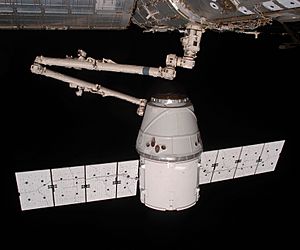
In 2006, SpaceX won a NASA contract to show they could deliver cargo to the ISS. NASA paid SpaceX $396 million to develop the cargo version of the Dragon spacecraft. SpaceX developed the Falcon 9 rocket with its own money. This partnership saved NASA a lot of money.
In December 2010, SpaceX became the first private company to successfully launch, orbit, and recover a spacecraft. Dragon successfully connected with the ISS in May 2012. This was a first for a private spacecraft.
NASA also awarded contracts for regular cargo deliveries to the ISS. The first contracts were signed in 2008. SpaceX received $1.6 billion for 12 cargo missions until 2016. The first of these missions launched in October 2012. Dragon stayed at the ISS for 20 days before returning to Earth.
CRS missions have flown about twice a year to the ISS since then. In 2015, NASA ordered more supply flights from SpaceX. The final Dragon 1 mission left the ISS in April 2020, and Dragon 1 was retired. A second phase of contracts was given in January 2016, and SpaceX was one of the winners. SpaceX will fly up to nine more CRS flights with the updated Dragon 2 spacecraft. In March 2020, NASA hired SpaceX to develop the Dragon XL spacecraft. This will send supplies to the Lunar Gateway space station. Dragon XL will launch on a Falcon Heavy.
Carrying Astronauts
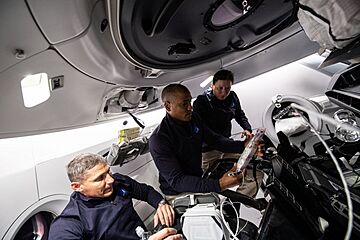
SpaceX is responsible for taking NASA astronauts to and from the ISS. NASA started this program to help private companies develop spacecraft for astronauts. SpaceX received its first contract in 2011. Another contract in 2012 helped them continue developing the Dragon 2 spacecraft.
In September 2014, NASA chose SpaceX and Boeing to develop systems for transporting U.S. astronauts. SpaceX received $2.6 billion to finish and approve Dragon 2 by 2017. The contracts required at least one test flight with astronauts. Once Crew Dragon was approved, SpaceX had to conduct at least two, and up to six, crewed missions to the space station.
SpaceX completed the first test flight of its Crew Dragon spacecraft in May 2015. It successfully conducted a full uncrewed test flight in early 2019. The capsule docked with the ISS and then landed in the Atlantic Ocean. In January 2020, SpaceX performed a test where the Dragon spacecraft fired its emergency escape engines during a simulated problem. This was the last test before flying astronauts.
On May 30, 2020, the Crew Dragon Demo-2 mission launched to the International Space Station. It carried NASA astronauts Bob Behnken and Doug Hurley. This was the first time a crewed vehicle had launched from the U.S. since 2011. It was also the first SpaceX commercial crewed launch to the ISS. The Crew-1 mission successfully launched to the International Space Station on November 16, 2020. It carried NASA and JAXA astronauts. On April 23, 2021, Crew-2 launched to the International Space Station with NASA, JAXA, and ESA astronauts. The Crew-2 mission successfully docked on April 24, 2021.
SpaceX also offers paid spaceflights for private individuals. The first of these missions, Inspiration4, launched in 2021. It carried four private citizens into low Earth orbit. All four crew members received training from SpaceX. This training included lessons on how things work in space, how to operate in no gravity, and emergency practice.
National Defense Missions
In 2005, SpaceX announced it had won a contract allowing the United States Air Force to buy up to $100 million worth of launches. Three years later, NASA gave SpaceX a contract for up to $1 billion. In December 2012, SpaceX announced its first two launch contracts with the United States Department of Defense (DoD). These were for the DSCOVR and STP-2 missions. DSCOVR launched on a Falcon 9 in 2015, and STP-2 launched on a Falcon Heavy in June 2019.
The Falcon 9 was approved for national security launches in 2015. This ended the monopoly that United Launch Alliance (ULA) had since 2006. In April 2016, the U.S. Air Force gave SpaceX its first national security launch contract. This was to launch a GPS III satellite for $82.7 million. This was about 40% less than similar missions had cost before. SpaceX also launched the third GPS III launch in June 2020. In March 2018, SpaceX got another $290 million contract to launch three more GPS III satellites.
The U.S. National Reconnaissance Office (NRO) also bought launches from SpaceX. The first one happened in May 2017. In February 2019, SpaceX got a $297 million contract to launch three more national security missions. In August 2020, the U.S. Space Force awarded its national security launch contracts for the next 5–7 years. SpaceX won a contract for $316 million for one launch. SpaceX will also handle 40% of the U.S. military's satellite launch needs during this time.
SpaceX also designs and launches special military satellites for the Space Development Agency. These are part of a new missile defense system in low Earth orbit. This system would help the United States detect and stop nuclear missiles and hypersonic weapons.
In March 2024, it was reported that SpaceX is building a network of hundreds of spy satellites. This new network would work together in low orbits.
Competition in the Launch Market
SpaceX's low launch prices have put pressure on other companies to lower their prices. Before 2013, the market for launching communication satellites was mostly controlled by Arianespace and International Launch Services. With a price of $56.5 million per launch to low Earth orbit, Falcon 9 rockets were the cheapest in the industry. European satellite companies are pushing the ESA to reduce the prices of their rockets because of competition from SpaceX.
SpaceX ended the monopoly that United Launch Alliance (ULA) had on U.S. military launches. In 2015, ULA said it might go out of business if it didn't win commercial satellite launch orders. To compete, ULA announced plans to cut its launch costs by half.
SpaceX said in 2017 that NASA's way of working with them helped them develop the Falcon 9 rocket at a much lower cost. NASA only set a general goal for cargo transport to the space station. They let SpaceX figure out the details. According to NASA, SpaceX's total cost to develop the Falcon 9 rocket was about $390 million. In 2011, NASA estimated it would have cost them about $4 billion to develop a similar rocket using their traditional methods. This is about ten times more. In May 2020, NASA's administrator said that thanks to NASA's investments in SpaceX, the United States now has 70% of the commercial launch market. This is a big improvement from 2012, when there were no commercial launches from the country.
As of 2024, SpaceX offers "Rideshare" and "Bandwagon" programs. These allow smaller satellites to share a ride on a larger rocket. This creates more competition for companies that launch small satellites.
Company Information
Business Trends
| Year | Revenue (billion USD) |
Valuation (billion USD) |
Number of employees |
|---|---|---|---|
| 2002 | ca. 30 | ||
| 2003 | |||
| 2004 | |||
| 2005 | ca. 90 (Feb.) ca. 160 (Nov.) |
||
| 2006 | |||
| 2007 | ca. 350 (Aug.) | ||
| 2008 | ca. 600 (Dec.) | ||
| 2009 | > 800 (Dec.) | ||
| 2010 | > 1,000 (June) | ||
| 2011 | ca. 1,300 (Jan.) | ||
| 2012 | 2.4 (June) | ca. 1,800 (May) | |
| 2013 | ca. 3,800 (Oct.) | ||
| 2014 | 10 (Aug.) | ||
| 2015 | 12 (Jan.) | ||
| 2016 | 15 (Nov.) | ca. 5,000 (Nov.) | |
| 2017 | 21 (Nov.) | ca. 7,000 (Nov.) | |
| 2018 | 27 (Apr.) | ||
| 2019 | 33 (May) | > 6,000 (July) | |
| 2020 | 1.8 | 46 (Aug.) | |
| 2021 | 2.3 | 74 (Feb.) 100 (Oct.) |
> 9,500 (March) |
| 2022 | 4.6 | 127 (Aug.) | ca. 12,000 (April) |
| 2023 | 9 | 137 (Jan.) 180 (Dec.) |
> 13,000 (Sept.) |
| 2024 | 13.1 |
350 (Dec.) | |
| 2025 | ca. 15.5 |
ca. 400 (July) |
Board of Directors
| Joined board | Name | Titles |
|---|---|---|
| 2002 | Elon Musk | Founder, chairman, CEO and CTO of SpaceX; CEO, Product Architect, and former chairman of Tesla; former chairman of SolarCity |
| 2002 | Kimbal Musk | Board member, Tesla |
| 2009 | Gwynne Shotwell | President and COO of SpaceX |
| Luke Nosek | Co-founder, PayPal | |
| Steve Jurvetson | Co-founder, Future Ventures fund | |
| 2010 | Antonio Gracias | CEO and Chairman of the Investment Committee at Valor Equity Partners |
| 2015 | Donald Harrison | President of global partnerships and corporate development, Google |
Leadership Changes
In November 2022, the company announced that COO Gwynne Shotwell and vice president Mark Juncosa would oversee Starbase. This showed how important it was to get Starship flying.
Workplace Culture
Some former employees have described a demanding work culture at SpaceX. They said employees were pushed to work very long hours and on weekends. This could lead to burnout. A rival company, Blue Origin, also noted that SpaceX expected very long work hours.
In 2023, Reuters reported that SpaceX employees were facing high injury rates. These rates were higher than the industry average. Reuters found at least 600 previously unreported workplace injuries at SpaceX. These included "crushed limbs, amputations, electrocutions, head and eye wounds and one death."
Government Investigations
In August 2023, the U.S. Department of Justice (DOJ) sued SpaceX. They said SpaceX discriminated against refugees and asylum seekers when hiring. The DOJ claimed SpaceX only hired U.S. citizens and permanent residents. SpaceX said it followed U.S. export control laws. In February 2025, the DOJ asked to drop the case.
In December 2024, federal agencies investigated SpaceX for security violations.
Environmental Impact
An investigation by NPR found that SpaceX has sometimes not followed environmental rules. They released large amounts of industrial wastewater into the environment. This can harm both people nearby and wildlife.
The Starship Flight 7 rocket explosion in January 2025 sent debris into the atmosphere. This debris spread across the Caribbean Sea. The incident also released a lot of harmful air pollution into Earth's upper atmosphere.
See also
 In Spanish: SpaceX para niños
In Spanish: SpaceX para niños


